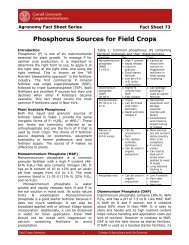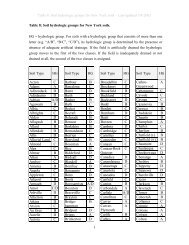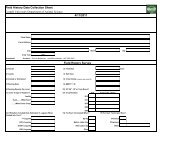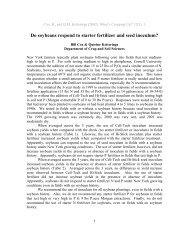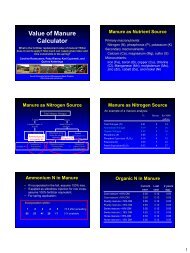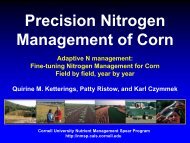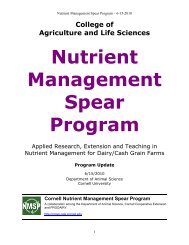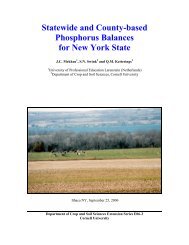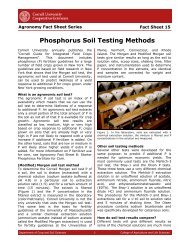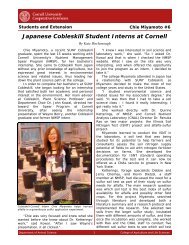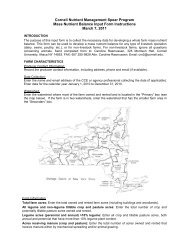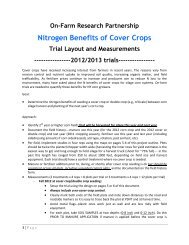potassium recommendations for field crops in new york - Cornell ...
potassium recommendations for field crops in new york - Cornell ...
potassium recommendations for field crops in new york - Cornell ...
You also want an ePaper? Increase the reach of your titles
YUMPU automatically turns print PDFs into web optimized ePapers that Google loves.
Potassium Recommendations <strong>for</strong> Field Crops <strong>in</strong> New York. CSS E01-6. October 2001.POTASSIUM RECOMMENDATIONSFOR FIELD CROPS IN NEW YORKQuir<strong>in</strong>e M. Ketter<strong>in</strong>gs, Stuart D. Klausner, and Karl J. CzymmekDepartment of Crop and Soil Sciences Extension Series E01-6<strong>Cornell</strong> UniversityOctober, 2001Picture by Q. M. Ketter<strong>in</strong>gsQuir<strong>in</strong>e M. Ketter<strong>in</strong>gs is an Assistant Professor of Nutrient Management <strong>in</strong> AgriculturalSystems, Department of Crop and Soil Sciences, <strong>Cornell</strong> University. Karl J. Czymmek isa Senior Extension Associate with PRO-DAIRY. Stuart D. Klausner is a retired SeniorExtension Associate <strong>in</strong> Nutrient Management, Department of Crop and Soil Sciences,<strong>Cornell</strong> University. For more <strong>in</strong><strong>for</strong>mation contact Quir<strong>in</strong>e Ketter<strong>in</strong>gs at the Department ofCrop and Soil Sciences, <strong>Cornell</strong> University, 817 Brad<strong>field</strong> Hall, Ithaca NY 14583 or e-mail: qmk2@cornell.edu.1
Potassium Recommendations <strong>for</strong> Field Crops <strong>in</strong> New York. CSS E01-6. October 2001.Acknowledgments:The agronomic <strong>potassium</strong> fertilizer <strong>recommendations</strong> <strong>for</strong> <strong>field</strong> <strong>crops</strong> are based ondecades of <strong>field</strong> research conducted <strong>in</strong> New York by The agronomic nitrogenfertilizer <strong>recommendations</strong> <strong>for</strong> <strong>field</strong> <strong>crops</strong> are based on decades of <strong>field</strong> researchconducted <strong>in</strong> New York by D.R. Bould<strong>in</strong>, S.D. Klausner, D.J. Lathwell W.S.Reid, retired faculty members at the Department of Crop and Soil Sciences,<strong>Cornell</strong> University.Correct citation:Ketter<strong>in</strong>gs, Q.M., S.D. Klausner and K.J. Czymmek (2001). Potassium<strong>recommendations</strong> <strong>for</strong> <strong>field</strong> <strong>crops</strong> <strong>in</strong> New York. Department of Crop and SoilSciences Extension Series E01-6. <strong>Cornell</strong> University, Ithaca, NY. 39 pages.@2001. All rights reserved.2
Potassium Recommendations <strong>for</strong> Field Crops <strong>in</strong> New York. CSS E01-6. October 2001.TABLE OF CONTENTS1. INTRODUCTION 52. POTASSIUM FORMS AND PLANT AVAILABILITY 53. SOIL MANAGEMENT GROUPS 53.1 Soil management group I 73.1.1 Subgroup IA 73.1.2 Subgroup IB 83.2 Soil management group II 93.2.1 Subgroup IIA 93.2.2 Subgroup IIB 103.2.3 Subgroup IIC 103.3 Soil management group III 103.3.1 Subgroup IIIA 103.3.2 Subgroup IIIB 113.4 Soil management group IV 123.5 Soil management group V 133.6 Muck soils 134. SOIL TEST INTERPRETATION AND CONVERSIONS 135. CALCULATING POTASSIUM RECOMMENDATIONS FOR SPECIFICFIELD CROPS 145.1 Corn, millet, sorghum, sorghum sudan hybrid, sudangrass andsunflowers 155.2 Soybeans 155.3 Established stands of alfalfa, alfalfa grass, and alfalfa birdsfoot trefoil 165.4 Established grasses, <strong>in</strong>tensively managed grass, and native grass pasture 175.5 Spr<strong>in</strong>g barley, w<strong>in</strong>ter barley, oats, and wheat 175.6 Buckwheat and rye cover crop 175.7 Triticale peas 185.8 Other <strong>crops</strong> 186. SOURCES OF POTASSIUM AND THEIR MANAGEMENT 19BACKGROUND LITERATURE 203
Potassium Recommendations <strong>for</strong> Field Crops <strong>in</strong> New York. CSS E01-6. October 2001.1. INTRODUCTIONAfter nitrogen and phosphorus, <strong>potassium</strong> (K) is the nutrient most likely to limitplant productivity. It is commonly applied to soils as a fertilizer. Potassium acts as anactivator <strong>for</strong> cellular enzymes <strong>in</strong>volved <strong>in</strong> processes such as energy metabolism, starchsynthesis, nitrate reduction, photosynthesis, nitrogen fixation, and sugar degradation.Potassium plays an important role <strong>in</strong> lower<strong>in</strong>g cellular osmotic potentials, allow<strong>in</strong>g plantsto conserve water transpiration from leaves and to <strong>in</strong>crease uptake through the roots.Plants with optimum <strong>potassium</strong> levels are known to be more resistant to environmentalstresses <strong>in</strong>clud<strong>in</strong>g drought.Presently, K is not considered a contam<strong>in</strong>ant <strong>in</strong> water or a threat to water quality.However, K should be managed appropriately to improve crop production economics,reduce loss, and to prevent excessive build up <strong>in</strong> soils. Excessive soil K may cause anaccumulation of K <strong>in</strong> the feed ration and pose a risk to milk production and animalhealth.2. POTASSIUM FORMS AND PLANT AVAILABILITYSoil K can be divided <strong>in</strong>to three major pools of availability. Unavailable ornonexchangeable <strong>potassium</strong> is conta<strong>in</strong>ed <strong>in</strong> the <strong>for</strong>m of soil m<strong>in</strong>erals (micas andfeldspars). These primary m<strong>in</strong>erals are the orig<strong>in</strong>al source of <strong>potassium</strong>. Plants cannot useK <strong>in</strong> these crystall<strong>in</strong>e <strong>in</strong>soluble <strong>for</strong>ms. However, over long periods of time, these soilm<strong>in</strong>erals weather and decompose, thereby releas<strong>in</strong>g K. Most of the soil <strong>potassium</strong> isconta<strong>in</strong>ed <strong>in</strong> the primary non-exchangeable m<strong>in</strong>eral <strong>for</strong>ms.Readily available K is composed of exchangeable and soil solution K. The totalamount of K <strong>in</strong> this pool is relatively small (one or two percent of the total K <strong>in</strong> the soil).Potassium is a positively charged ion (cation). It does not leach readily because of itsattraction to the soil's negative charge. However, K can leach <strong>in</strong> very sandy soils with alow cation exchange capacity.Slowly available or exchangeable K is part of the <strong>in</strong>ternal structure of claym<strong>in</strong>erals of the soil. Some of the readily soluble K applied <strong>in</strong> fertilizer and manure maybe temporarily converted to a more slowly available <strong>for</strong>m with<strong>in</strong> the clay structure.Much of the K required <strong>for</strong> crop production can be derived from the pool ofexchangeable K. Some <strong>potassium</strong> may be returned to the soil as a result of leach<strong>in</strong>g fromplant foliage by ra<strong>in</strong>water or irrigation.3. SOIL MANAGEMENT GROUPSNew York agricultural soils are divided <strong>in</strong>to five m<strong>in</strong>eral soil management groupsand a sixth group that <strong>in</strong>cludes organic (muck) soils, urban soils, the AdirondackMounta<strong>in</strong>s, Tug Hill and primarily rock land (Figure 1). There is a good correlationbetween the groups and their ability to supply K. The five m<strong>in</strong>eral groups are classified5
Potassium Recommendations <strong>for</strong> Field Crops <strong>in</strong> New York. CSS E01-6. October 2001.accord<strong>in</strong>g to texture of the surface and subsoil and parent material (lake sediments,calcareous glacial till, glacial outwash and recent alluvium). Table 1 gives an overview ofthe five m<strong>in</strong>eral soil management groups. A complete list of New York soils and theirsoil management group classification can be found <strong>in</strong> Appendix Table 2. In the follow<strong>in</strong>gsections, each of the soil management groups are discussed briefly.Figure 1: Soils and soil management groups of New York. Pr<strong>in</strong>ted with permission fromthe <strong>Cornell</strong> Field Crops and Soils Handbook (1987). <strong>Cornell</strong> Cooperative Extension.Ithaca NY.6
Potassium Recommendations <strong>for</strong> Field Crops <strong>in</strong> New York. CSS E01-6. October 2001.Table 1: Soil management groups <strong>for</strong> New York State agricultural soils (modified from:<strong>Cornell</strong> Field Crops and Soils Handbook, <strong>Cornell</strong> Cooperative Extension, 1987).SoilManagementGroupGeneral DescriptionIIIIIIIVVVIF<strong>in</strong>e-textured soils developed from clayey lake sediments and mediumtof<strong>in</strong>e-textured soils developed from lake sediments.Medium- to f<strong>in</strong>e-textured soils developed from calcareous glacial tilland medium-textured to moderately f<strong>in</strong>e-textured soils developed fromslightly calcareous glacial till mixed with shale and medium-texturedsoils developed <strong>in</strong> recent alluvium.Moderately course textured soil developed from glacial outwash andrecent alluvium and medium-textured acid soil developed on glacial till.Course- to medium-textured soils <strong>for</strong>med from glacial till or glacialoutwash.Course- to very course-textured soils <strong>for</strong>med from gravelly or sandyglacial outwash or glacial lake beach ridges or deltas.Organic or muck soils with more than 80% organic matter.3.1 Soil management group IThe soils <strong>in</strong> this management group are medium- to f<strong>in</strong>e-textured soil s developedfrom lake sediments. They are heavy-textured, generally wet soils <strong>for</strong>med from lake ormar<strong>in</strong>e sediments deposited <strong>in</strong> glacial lakes. They are characterized by a very slowlypermeable subsurface of silty clay to clay.3.1.1 Subgroup IAThese are f<strong>in</strong>e-textured soils developed from clayey lake sediments. These are theheavy, generally wet soils <strong>for</strong>med from lake or mar<strong>in</strong>e sediments with silty clay loam toclay surfaces over heavier silty clay to clay subsoils. They conta<strong>in</strong> little or no sand orgravel. The slope is generally level or nearly level, and the topography is level toundulat<strong>in</strong>g. Their very slowly permeable profile and nearly level slopes makes soil7
Potassium Recommendations <strong>for</strong> Field Crops <strong>in</strong> New York. CSS E01-6. October 2001.dra<strong>in</strong>age and water management difficult but very important. Land smooth<strong>in</strong>g and openditches with good outlets are recommended. Rotations conta<strong>in</strong><strong>in</strong>g sod <strong>crops</strong>, culturalpractices such as fall plow<strong>in</strong>g, the <strong>in</strong>corporation of organic residues, and timely fitt<strong>in</strong>goperations at proper moisture conditions, should be used to ma<strong>in</strong>ta<strong>in</strong> good soil tilth <strong>for</strong>optimum crop yields. The water-hold<strong>in</strong>g capacity of these soils is high; but because oflimited root<strong>in</strong>g <strong>in</strong> the clayey subsoils, <strong>crops</strong> suffer from drought more frequently thanwhen grown on groups II or III soils.The soil pH ranges from 5.4 to 7.0; thus lime may or may not be needed. If the pHis low, large quantities of lime are required. Magnesium on these soils is usually adequateto high. The organic matter contents are generally high, but the release of nitrogen (N) isslow, especially <strong>in</strong> the spr<strong>in</strong>g because of the cold, wet nature of these soils. The nitrogen -supply<strong>in</strong>g power of these soils usually exceeds 80 pounds per acre per year. Theefficiency of applied N is often low, especially if applied preplant. These heavy-texturedsoils are often waterlogged, and some N is lost by denitrification. Side-dress<strong>in</strong>g N<strong>in</strong>creases its efficiency.Phosphorus (P) is usually low, and the placement of P <strong>in</strong> the band near the seed atplant<strong>in</strong>g is critical. The heavy soil texture and wet, cold spr<strong>in</strong>g conditions slow rootgrowth. Thus the roots cannot extract nutrients from a large volume of soil. This reducesP uptake and <strong>in</strong>creases the probability of a response when placed <strong>in</strong> the fertilizer band.The K supply<strong>in</strong>g power is high, but restricted root growth decreases the ability of theplant to extract K; there<strong>for</strong>e, some K conta<strong>in</strong><strong>in</strong>g fertilizers are needed.The corn yields <strong>in</strong> this subgroup are generally below 100 bu/acre (17 tons per acreof silage), except <strong>for</strong> the moderately well dra<strong>in</strong>ed Vergennes and Wilpo<strong>in</strong>t soils. Theyield potential <strong>for</strong> perennial <strong>for</strong>ages ranges from 2.5 to 4.5 tons /acre. Birdfoot trefoil andgrass are usually the most appropriate species to grow. Examples from group IA clayeysoils are the moderately well dra<strong>in</strong>ed Vergennes, the somewhat poorly dra<strong>in</strong>edK<strong>in</strong>gsbury, and the poorly dra<strong>in</strong>ed Liv<strong>in</strong>gston soils. Large acreages of group IA soilsoccur <strong>in</strong> northern New York with limited acres (not shown on figure 1) <strong>in</strong> eastern NewYork and the Hudson Valley.3.1.2 Subgroup IBThese are medium- to f<strong>in</strong>e-textured soils developed from lake sediments. Thesesoils are <strong>for</strong>med from glacial lake or mar<strong>in</strong>e deposits and have a permeable, very f<strong>in</strong>esandy loam, silt loam, or silty clay loam surface over a more slowly permeable, heaviersilty clay loam to clay subsurface. They differ from subgroup IA because of the moresandy surface and usually a more permeable subsoil. They generally occur on nearly levelto gently slop<strong>in</strong>g or roll<strong>in</strong>g landscapes of the lower elevations near the lakes and alongthe Hudson River. The more roll<strong>in</strong>g landscape makes surface water control and dra<strong>in</strong>ageeasier than on the nearly level areas, but it <strong>in</strong>creases the erosion hazard. Water anderosion control are important <strong>in</strong> manag<strong>in</strong>g these soils <strong>for</strong> crop production.The pH of these soils ranges from 5.2 to 7.4, but most often the pH is 5.8 orabove. Most subgroup IB soils need some lime <strong>for</strong> alfalfa production. The magnesium(Mg) supply is usually adequate.8
Potassium Recommendations <strong>for</strong> Field Crops <strong>in</strong> New York. CSS E01-6. October 2001.The organic matter content is generally medium, and the N release is good on thewell-dra<strong>in</strong>ed to moderately well dra<strong>in</strong>ed soils. The N-supply<strong>in</strong>g power generally exceeds80 lbs per acre per year, but nitrogen loss is a problem as with the subgroup IA soils.Orig<strong>in</strong>al P levels are low, but the addition of manure and fertilizer P to cultivatedareas may have <strong>in</strong>creased soil P to higher levels. Band placement of P is important <strong>for</strong>crop establishment where P application is recommended. The K-supply<strong>in</strong>g power is high,but cont<strong>in</strong>uous cropp<strong>in</strong>g without adequate fertilizer can reduce the K levels.The yield potentials <strong>for</strong> these soils vary from 75 to 120 bushels of corn per acre(13 to 20 tons of silage) depend<strong>in</strong>g on the soil dra<strong>in</strong>age. The potential yields of perennial<strong>for</strong>age range from 2.5 to 5.5 tons per acre, but only the well-dra<strong>in</strong>ed and moderately welldra<strong>in</strong>ed soils are suited <strong>for</strong> alfalfa production. The Hudson, Odessa, and Schoharie seriesare examples of the well-dra<strong>in</strong>ed and moderately well dra<strong>in</strong>ed soils of the subgroup IB.Other examples are the somewhat poorly and poorly dra<strong>in</strong>ed Caneadea, Canadice, andRh<strong>in</strong>ebeck soils and the very poorly dra<strong>in</strong>ed Lakemont soils.3.2 Soil management group IIThe soils of this group are medium-textured to moderately f<strong>in</strong>e-textured soilsdeveloped from calcareous glacial till, calcareous glacial till mixed with shale, or recentalluvium. The soils <strong>in</strong> this management group belong to one of three subgroupsdepend<strong>in</strong>g on parent material. Yield potentials of these soils vary from 75 to 150 bushelsor corn (13-26 tons per acre of corn silage) and from 2.5 to 6 tons per acre of <strong>for</strong>age,depend<strong>in</strong>g primarily on the soil dra<strong>in</strong>age characteristics.3.2.1 Subgroup IIAMedium- to f<strong>in</strong>e-textured soils developed from calcareous glacial till. These soilsare found <strong>in</strong> areas of undulat<strong>in</strong>g to gently roll<strong>in</strong>g topography <strong>in</strong> the central pla<strong>in</strong>s of NewYork. They are <strong>for</strong>med from strongly calcareous glacial till. The soil profile is slightlyacid to slightly alkal<strong>in</strong>e <strong>in</strong> the surface and slightly alkal<strong>in</strong>e or strongly alkal<strong>in</strong>e <strong>in</strong> thesubsoil. The surface texture may be a very f<strong>in</strong>e sandy loam, loam, or silt loam with siltloam to silty clay loam subsoils. The water-hold<strong>in</strong>g capacity of these soils is high. Limeis usually not required, but surface soil pH’s are occasionally low. Additions of manureand fertilizer P have <strong>in</strong>creased the P content to high levels <strong>in</strong> some soils.Soil water management is a problem on most of these soils. Erosion control andadequate soil dra<strong>in</strong>age are critical problems. Subsurface dra<strong>in</strong>age is effective <strong>in</strong> remov<strong>in</strong>gexcess soil water. Strip-cropp<strong>in</strong>g, diversion ditches, sod waterways, and subdra<strong>in</strong> outletterraces have successfully provided both erosion control and dra<strong>in</strong>age. Once the watermanagement problems have been solved, these are among the most productive soils ofthe state.Some examples are the well-dra<strong>in</strong>ed Cazenovia, Hilton, Honeoye, Lima andOntario series; the somewhat poorly dra<strong>in</strong>ed Appleton, Kendaia, and Ovid series; and thepoorly dra<strong>in</strong>ed Lyons and Romulus series.9
Potassium Recommendations <strong>for</strong> Field Crops <strong>in</strong> New York. CSS E01-6. October 2001.3.2.2 Subgroup IIBMedium-textured to moderately f<strong>in</strong>e textured soils developed from slightlycalcareous glacial till mixed with shale. These soils generally have a very f<strong>in</strong>e sandyloam or silt loam surface over a heavy silt loam or silty clay loam subsurface. These soilsoccur on nearly level or slightly undulat<strong>in</strong>g to roll<strong>in</strong>g landscapes and are generallylocated <strong>in</strong> the transition zone to the higher lime soils. The slop<strong>in</strong>g landscapes often showsigns of erosion, and erosion control practices are generally necessary. On the more levelor concave topography and f<strong>in</strong>er-textured soils, dra<strong>in</strong>age is a problem. The better-dra<strong>in</strong>edsoils of this group are well suited <strong>for</strong> the production of almost all <strong>field</strong> <strong>crops</strong> andvegetables. Almost all soils of this group require lime <strong>for</strong> legumes, and many must belimed <strong>for</strong> optimum production of other <strong>field</strong> <strong>crops</strong>. In general, the organic matter and N<strong>in</strong> these soils are medium. The orig<strong>in</strong>al P supply was low, but P additions have <strong>in</strong>creasedit to high levels <strong>in</strong> some soils. The K supply is high. Some examples are the well-dra<strong>in</strong>edto moderately well dra<strong>in</strong>ed Conesus, Lans<strong>in</strong>g, Mohawk, and Nunda series. The somewhatpoorly to poorly dra<strong>in</strong>ed members <strong>in</strong>clude the generally f<strong>in</strong>er textured Burdett, Darien,Kendaia, and Manheim series.3.2.3 Subgroup IICMedium-textured soils developed <strong>in</strong> recent alluvium. These soils have developedon nearly level, first bottomlands and are subject to spr<strong>in</strong>g floods. The better-dra<strong>in</strong>edsoils are <strong>in</strong>tensively used and highly productive <strong>for</strong> a wide variety of <strong>crops</strong>. They have awater-hold<strong>in</strong>g capacity of 5 to 9 <strong>in</strong>ches of available water. These are among the mostfertile soils <strong>in</strong> New York. Crops grown on these soils respond to practices that improvesoil tilth and m<strong>in</strong>imize soil compaction. Examples are the well-dra<strong>in</strong>ed Haml<strong>in</strong> orGenesee, moderately well dra<strong>in</strong>ed Teel, and somewhat poorly dra<strong>in</strong>ed Wayland.3.3 Soil management group IIIThe soils <strong>in</strong> this management group are medium-textured silt loams <strong>in</strong> both thesurface and the subsoil. They are medium <strong>in</strong> K supply<strong>in</strong>g power. There are twosubgroups <strong>in</strong> this category that are similar <strong>in</strong> most of their management requirements butcan differ <strong>in</strong> parent material, slope, tillage, and erosion control practices.3.3.1 Subgroup IIIAModerately coarse textured soil developed from recent alluvium. These soilsgenerally have a sandy loam, gravelly loam, or gravelly silt loam surface and gravellyloam, loam, sand or gravel subsurfaces. They occur on gravel outwash pla<strong>in</strong>s <strong>in</strong> the10
Potassium Recommendations <strong>for</strong> Field Crops <strong>in</strong> New York. CSS E01-6. October 2001.valleys or on glacial kames or eskers. The majority is level to nearly level and are wellsuited to a variety of <strong>crops</strong>. Erosion and soil structure are generally not problems. Thesesoils conta<strong>in</strong> about 4 to 7 <strong>in</strong>ches of available water <strong>in</strong> the soil profile. Irrigation may berequired <strong>for</strong> vegetable production or dur<strong>in</strong>g dry years <strong>for</strong> <strong>field</strong> <strong>crops</strong>.The soils located near the high lime glacial tills are usually higher <strong>in</strong> pH than thesoils <strong>in</strong> the southern part of the state, but lime must be added to most of these soils <strong>for</strong>optimum crop production. Yield potentials <strong>for</strong> this group are high with corn yieldsgenerally between 110 and 130 bushels per acre on the well-dra<strong>in</strong>ed and moderately welldra<strong>in</strong>ed areas. Perennial <strong>for</strong>age yields range from 2.5 to 5.8 tons per acre depend<strong>in</strong>g onsoil dra<strong>in</strong>age. Examples are the well-dra<strong>in</strong>ed to moderately well dra<strong>in</strong>ed Barbour,Braceville, Chenango, Howard, Kars, Palmyra, Phelps, and Tioga series. The somewhatpoorly dra<strong>in</strong>ed soils <strong>in</strong>clude the Fredon, Holly, and Red Hook series.3.3.2 Subgroup IIIBThese are medium-textured acid soils with fragipans developed on glacial till.These soils conta<strong>in</strong> shale, sandstone, slate, or schist-type rocks with little or no lime.They have a silt loam surface and a more dense or compacted silt loam subsoil withfragipan or hardpan at various depths below the surface. The depth to the fragipandeterm<strong>in</strong>es the soil dra<strong>in</strong>age characteristics – the deeper the pan, the better dra<strong>in</strong>ed thesoil. The entire profile conta<strong>in</strong>s few to many angular and (or) flat stones of various sizes.The well-dra<strong>in</strong>ed and moderately well dra<strong>in</strong>ed soils usually conta<strong>in</strong> 4 to 7 <strong>in</strong>ches ofavailable water; the somewhat poorly dra<strong>in</strong>ed soils conta<strong>in</strong> 3 to 4 <strong>in</strong>ches. Erosion is aproblem on all soils with<strong>in</strong> this group. These slop<strong>in</strong>g soils must be protected to reduceerosion by us<strong>in</strong>g comb<strong>in</strong>ations of cover <strong>crops</strong>, strip-cropp<strong>in</strong>g, rotations, and diversionditches.The pattern of soils with<strong>in</strong> a <strong>field</strong> is usually complex because of the variableslopes. Most <strong>field</strong>s will conta<strong>in</strong> two or more soils with different dra<strong>in</strong>age characteristics;that is, the majority of a <strong>field</strong> may be moderately well dra<strong>in</strong>ed soil such as Mard<strong>in</strong>, but <strong>in</strong>the low places a poorly dra<strong>in</strong>ed soil such as Chippewa will occur. This type of soilpattern required diversion terraces to <strong>in</strong>tercept runoff from higher elevations and randomsubdra<strong>in</strong>age to elim<strong>in</strong>ate wet spots. Such practices permit more timely, efficient farmoperations. Yield potentials <strong>for</strong> the subgroup IIIB soils are generally lower than <strong>for</strong>subgroup IIIA because water is often a problem.The well-dra<strong>in</strong>ed and moderately well dra<strong>in</strong>ed soils generally occur on the convexslopes near the top of the hills, on the knolls, or on slop<strong>in</strong>g areas where there is no waterseepage. These <strong>in</strong>clude the Mard<strong>in</strong>, Valois, and Lang<strong>for</strong>d soils. The well-dra<strong>in</strong>edLordstown and Oquaga soils occur on steeper slopes and are shallow to bedrock. Thesomewhat poorly and poorly dra<strong>in</strong>ed soils such a Camroden, Ellery, Erie, Marcy, Morris,and Volusia occur on the longer slopes, and near the bases of hills where water tends tocollects or seep from above.11
Potassium Recommendations <strong>for</strong> Field Crops <strong>in</strong> New York. CSS E01-6. October 2001.3.4 Soil management group IVThese soils are low <strong>in</strong> K-supply<strong>in</strong>g power and are coarse- to moderately coarsetexturedsoils <strong>for</strong>med from glacial till or glacial outwash (Figure 2). There is nosubdivision of the soil management IV. The soil texture is sandy loam or silt loam <strong>in</strong> thesurface, with or without gravel. The subsurface ranges from gravelly loams to clays. Theslopes vary from level to strongly undulat<strong>in</strong>g. The somewhat poorly to poorly dra<strong>in</strong>edsoils of this group can usually be dra<strong>in</strong>ed effectively with widely spaced tile l<strong>in</strong>es.Picture by K.J. Czymmek.Figure 2: Glacial <strong>in</strong>fluences set the stage <strong>for</strong> soil managementgroups.These soil profiles usually have an available water capacity of 3 to 5 <strong>in</strong>ches.Crops grown on these soils suffer from <strong>in</strong>sufficient water dur<strong>in</strong>g extended dry periods,especially as the water table is more than 2 to 3 feet <strong>in</strong> depth. The soil tilth is excellent,and the soils can be worked over a wide range of moisture conditions without <strong>in</strong>jury.Erosion from w<strong>in</strong>d and water may be a problem <strong>in</strong> some areas. Most of these soils requireregular additions of lime <strong>for</strong> crop growth. Crops respond well to fertilizers when moistureis adequate. Examples of the well-dra<strong>in</strong>ed to moderately well dra<strong>in</strong>ed soils of this groupare Bombay, Broadalb<strong>in</strong>, Copake, Empeyville, Gloucester, Grenville, Hogansburg,Hoosic, Ira, Madrid, Moira, Parishville, Sodus, and Worth. Some somewhat poorly topoorly dra<strong>in</strong>ed examples are Brayton, Fredon, Massena, Scriba, and Westbury.12
Potassium Recommendations <strong>for</strong> Field Crops <strong>in</strong> New York. CSS E01-6. October 2001.3.5 Soil management group VThese are coarse- to very coarse-textured soils <strong>for</strong>med from gravelly or sandyglacial outwash or glacial lake beach ridges or deltas. The parent material <strong>for</strong> these soilshas been reworked by water either as glacial outwash or by wave action from the glaciallakes, remov<strong>in</strong>g almost all the f<strong>in</strong>e materials, silt, and clay and leav<strong>in</strong>g usually deepdeposits of sand and/or gravel. The soils that <strong>for</strong>m have similar textures, usually withlittle organic matter. The topography is nearly level to undulat<strong>in</strong>g. Most of these soils areexcessively dra<strong>in</strong>ed. The available water capacity is very low, 2 to 3 <strong>in</strong>ches.Supplemental irrigation is essential <strong>for</strong> consistent crop production. The tilth of these soilsis generally good to loose. They can be worked at almost any time follow<strong>in</strong>g a ra<strong>in</strong> andare commonly used <strong>for</strong> produc<strong>in</strong>g fresh market vegetable <strong>crops</strong>. They require small, butregular, additions of lime. The fertility needs are great. The soils usually supply less than50 pounds per acre of available N or K. Leach<strong>in</strong>g of fertilizer N and K is a problem, andadditional N and K should be added to the irrigated soils. Without irrigation these soilshave low yields, generally less than 90 bushels per acre of corn and 4.5 tons of alfalfa.Examples of the excessively dra<strong>in</strong>ed to well-dra<strong>in</strong>ed soils <strong>in</strong>clude Alton, Colosse, Colton,H<strong>in</strong>ckley, and W<strong>in</strong>dsor. The somewhat poorly and poorly dra<strong>in</strong>ed soils <strong>in</strong>cludeClaverack, Colonie, Elmwood, Granby, Junius, and Swanton.3.6 Muck soilsMuck is <strong>for</strong>med by deposits of decay<strong>in</strong>g organic matter <strong>in</strong> bogs. Muck lands mustbe dra<strong>in</strong>ed be<strong>for</strong>e they can be used <strong>for</strong> agriculture. Water management is extremelyimportant not only <strong>for</strong> dra<strong>in</strong>age <strong>for</strong> crop production but also <strong>for</strong> irrigation and control ofthe rate of decay of the organic matter. Muck soils are usually high <strong>in</strong> N, but low <strong>in</strong> P, K,copper and magnesium. The deep mucks may have marl mixed with, or very close to, thesurface. This complicates the fertility program, especially <strong>for</strong> z<strong>in</strong>c and manganese.The muck soils are generally used <strong>for</strong> the production of vegetable <strong>crops</strong>, but <strong>field</strong><strong>crops</strong> are sometimes grown. When used <strong>for</strong> <strong>field</strong> <strong>crops</strong>, they should be fertilized withphosphorus and <strong>potassium</strong> as <strong>in</strong>dicated <strong>in</strong> the section <strong>for</strong> soil management group V but Napplication rates should be reduced one-third to one-half of the rates recommended <strong>for</strong>m<strong>in</strong>eral soils.4. SOIL TEST INTERPRETATION AND CONVERSIONS<strong>Cornell</strong> University’s <strong>potassium</strong> <strong>recommendations</strong> are based on decades of yieldresponse trials <strong>in</strong> New York. The Morgan extraction is the basis <strong>for</strong> these<strong>recommendations</strong>. <strong>Cornell</strong> soil K tests can be <strong>in</strong>terpreted us<strong>in</strong>g Table 2.13
Potassium Recommendations <strong>for</strong> Field Crops <strong>in</strong> New York. CSS E01-6. October 2001.Table 2: Interpretations of <strong>Cornell</strong> soil test K data.SoilManagementGroupSoil test KVery Low Low Medium High Very High---------------------Lbs K/acre (CNAL Morgan extraction)--------------------I 149II 164III 199IV 239V/VI 269Mehlich-III soil tests from Brookside Laboratories Inc. (New Knoxville, Ohio)and Mehlich-III based soil test results reported by Spectrum Analytic Inc. (Wash<strong>in</strong>gtonC.H., Ohio) can be used to derive <strong>Cornell</strong> Morgan equivalents:Brookside Laboratories Inc. (n=235, r 2 =0.94, range = 84 to 1434 lbs K/acre):CNAL Morgan K (lbs/a) = 1.08 * Brookside K (lbs/acre) - 50Spectrum Analytic Inc. (n=235, r 2 =0.94, range = 36 to 1646 lbs K/acre):CNAL Morgan K (lbs/a) = 0.92 * Spectrum K (lbs/acre) – 10These equations are derived from a dataset with CNAL Morgan extractable K rang<strong>in</strong>gfrom 39 to 1809 lbs K/acre. Soil pH <strong>in</strong> water ranged from 4.4 to 7.8. Comparative studiesare necessary to derive CNAL Morgan equivalents <strong>for</strong> Mehlich-III data from otherlaboratories.5. CALCULATING POTASSIUM REQUIREMENTS FOR SPECIFIC CROPSPotassium requirements are expressed <strong>in</strong> lbs of K 2 O. The K <strong>recommendations</strong> <strong>for</strong>sod <strong>crops</strong> depend on yield potential, soil test K level and constants associated with thesoil type. Non-sod crop K requirements depend on soil test K level and constantsassociated with the soil type.14
Potassium Recommendations <strong>for</strong> Field Crops <strong>in</strong> New York. CSS E01-6. October 2001.5.1 Corn, millet, sorghum, sorghum sudan hybrid, sudangrass and sunflowersPotassium requirements <strong>for</strong> corn (COG, COS), millet (MIL) sorghum <strong>for</strong>age (SOF),sorghum gra<strong>in</strong> (SOG), sorghum sudan hybrids (SSH), sudangrass (SUD) and sunflowers(SUN) are calculated us<strong>in</strong>g the follow<strong>in</strong>g K requirement equation:K 2 O recommendation (lbs/acre) = 20 + A – SoilTestKSee Table 3 <strong>for</strong> the A parameter and m<strong>in</strong>imum and maximum <strong>recommendations</strong>. If thesoil test K level is higher than 150% of the A value of a specific soil management group,the <strong>potassium</strong> requirement becomes zero. For crop establishment and topdress<strong>in</strong>g<strong>potassium</strong>, manure can be used to supply the entire requirement. Appendix Table Bshows the K <strong>recommendations</strong> <strong>for</strong> each of these <strong>crops</strong> by <strong>Cornell</strong> Morgan soil test Klevel.Table 3: Fitt<strong>in</strong>g parameters A and B and m<strong>in</strong>imum and maximum K 2 O <strong>recommendations</strong><strong>for</strong> gra<strong>in</strong> corn (COG), corn silage (COS), millet (MIL, ) sorghum <strong>for</strong>age (SOF), sorghumgra<strong>in</strong> (SOG), sorghum sudan hybrids (SSH), sudangrass (SUD) and sunflowers (SUN).SoilManagementGroupFitt<strong>in</strong>gParameterAM<strong>in</strong>imumRecommendation(COG, COS,MIL, SOF, SOG,SSH, SUD, SUN)(COG, COS)MaximumRecommendation(MIL, SOF, SOG,SSH, SUD, SUN)------------------------ Lbs K 2 O/acre -------------------------I 100 20 50 50II 110 20 60 60III 130 20 80 70IV 160 20 120 80V/VI 180 20 120 1005.2 SoybeansThe K <strong>recommendations</strong> <strong>for</strong> soybean are listed <strong>in</strong> Table 4.15
Potassium Recommendations <strong>for</strong> Field Crops <strong>in</strong> New York. CSS E01-6. October 2001.Table 4: Potassium <strong>recommendations</strong> (lbs K 2 O/acre) <strong>for</strong> soybeans.CNAL Morgan extractable KSoil Management Grouplbs K/acre I, II III IV, V, VI269 0 0 05.3 Established stands of alfalfa, alfalfa grass, and alfalfa birdsfoot trefoilThe <strong>potassium</strong> <strong>recommendations</strong> <strong>for</strong> established stands of alfalfa (ALT), alfalfagrass (AGT) and alfalfa birdsfoot trefoil (ABT) are derived us<strong>in</strong>g the follow<strong>in</strong>gequations:Soil management group I:K recommendation (lbs K 2 O/acre) = [{(ypa * 40) – SoilTestK} / 0.6] – 120Soil management group II:K recommendation (lbs K 2 O/acre) = [{(ypa * 40) – SoilTestK} / 0.6] – 100Soil management group III:K recommendation (lbs K 2 O/acre) = [{(ypa * 40) – SoilTestK} / 0.6] – 80Soil management group IV:K recommendation (lbs K 2 O/acre) = [{(ypa * 40) – SoilTestK} / 0.6] – 60Soil management group V and VI:K recommendation (lbs K 2 O/acre) = [{(ypa * 40) – SoilTestK} / 0.6] – 40In these equations, ypa is the soil specific alfalfa yield potential <strong>in</strong> tons/acre andSoilTestK is the lbs CNAL Morgan extractable K/acre. Soil type specific yield potentials<strong>for</strong> alfalfa can be found <strong>in</strong> Appendix Table C.16
Potassium Recommendations <strong>for</strong> Field Crops <strong>in</strong> New York. CSS E01-6. October 2001.5.4 Potassium requirements <strong>for</strong> established grasses, <strong>in</strong>tensively managed grass, and nativegrass pasturePotassium <strong>recommendations</strong> <strong>for</strong> established and <strong>in</strong>tensively managed grass (GIT)and established grasses (GRT) and native grass pasture (PNT) are derived from those <strong>for</strong>topdress<strong>in</strong>g alfalfa (ALT):GIT K recommendation (lbs K 2 O/acre) = 0.8 * ALT K <strong>recommendations</strong>GRT/PNT K recommendation (lbs K 2 O/acre) = 0.66 * ALT K <strong>recommendations</strong>Derivations <strong>for</strong> <strong>potassium</strong> <strong>recommendations</strong> <strong>for</strong> established alfalfa were discussed <strong>in</strong>section 5.3.5.5 Spr<strong>in</strong>g barley, w<strong>in</strong>ter barley, oats, and wheatPotassium requirements <strong>for</strong> spr<strong>in</strong>g barley (BSP), w<strong>in</strong>ter barley (BWI), oats (OAT)and wheat (WHT) are calculated us<strong>in</strong>g the follow<strong>in</strong>g general K requirement equation:K recommendation (lbs K 2 O /acre) = 110 – (0.70 * SoilTestK)In this equation, SoilTestK is the amount of CNAL Morgan extractable K <strong>in</strong> lbs/acre. The<strong>recommendations</strong> <strong>for</strong> these <strong>crops</strong> do not depend on soil management group. The<strong>recommendations</strong> become zero lbs/acre <strong>for</strong> soil with soil test K levels of 157 lbs/acre orhigher. Appendix Table D shows the K <strong>recommendations</strong> <strong>for</strong> these <strong>crops</strong> as a function ofsoil test K level.5.6 Buckwheat and rye cover cropBecause buckwheat (BUK) is well-adapted to poor soils and easily lodges onhighly fertile soils, no K 2 O is recommended <strong>for</strong> soil with soil test K levels of 10 lbs/acre(CNAL Morgan soil test) or higher. The K recommendation <strong>for</strong> a rye cover crop (RYC)is identical to that of buckwheat. The maximum K recommendation amounts to 50 lbsK 2 O/acre on soils with virtually no extractable K. Recommendations decrease with 5 lbsK 2 O/acre <strong>for</strong> each lb/acre <strong>in</strong>crease <strong>in</strong> soil test K (SoilTestK <strong>in</strong> lbs K/acre):K recommendation (lbs K 2 O/acre) = 50 – (5 * SoilTestK)Appendix Table E shows K <strong>recommendations</strong> <strong>for</strong> buckwheat and rye cover <strong>crops</strong> as afunction of CNAL Morgan extractable soil test K level.17
Potassium Recommendations <strong>for</strong> Field Crops <strong>in</strong> New York. CSS E01-6. October 2001.5.7 Triticale peasTriticale peas <strong>recommendations</strong> are soil test but not soil management groupspecific. Recommendations follow the general equation:K recommendation (lbs K 2 O /acre) = (110 – SoilTestK)*0.70In this equation, SoilTestK is the amount of CNAL Morgan extractable K <strong>in</strong> lbs/acre. Them<strong>in</strong>imum requirement is 20 lbs K 2 O/acre. Appendix Table F list K <strong>recommendations</strong>as a function of <strong>Cornell</strong> Morgan soil test level.5.8 Other <strong>crops</strong>Table 5 lists other <strong>crops</strong> <strong>for</strong> which K <strong>recommendations</strong> are available. Potassium<strong>recommendations</strong> <strong>for</strong> these <strong>crops</strong> are calculated us<strong>in</strong>g the follow<strong>in</strong>g equations:Soil management group I:K recommendation (lbs K 2 O /acre) = (100 - SoilTestK)*0.70Soil management group II:K recommendation (lbs K 2 O /acre) = (110 - SoilTestK)*0.70Soil management group III:K recommendation (lbs K 2 O /acre) = (130 - SoilTestK)*0.80Soil management group IV:K recommendation (lbs K 2 O /acre) = (160 - SoilTestK)*0.90Soil management group V and VI:K recommendation (lbs K 2 O /acre) = (200 - SoilTestK)*0.70Appendix Table G shows K <strong>recommendations</strong> as a function of <strong>Cornell</strong> Morgan soil test Klevel of each of the soil management groups. A m<strong>in</strong>imum application of 20 lbs K 2 O isrecommended <strong>for</strong> all <strong>crops</strong> except <strong>for</strong> established birdsfoot trefoil (BTT), birdsfoot trefoilclover (BCT), birdsfoot trefoil grass (BGT), and birdsfoot trefoil seed. A maximumapplication applies <strong>for</strong> rye seed production (RYC), established pasture of improvedgrasses and <strong>in</strong>tensively grazed pasture. Maximum application rates <strong>for</strong> these <strong>crops</strong>amount to 50, 60, 70, 80 and 100 lbs K 2 O/acre <strong>for</strong> soils <strong>in</strong> management groups I, II, III,IV, V/VI, respectively.18
Potassium Recommendations <strong>for</strong> Field Crops <strong>in</strong> New York. CSS E01-6. October 2001.Table 5: Crops and their <strong>Cornell</strong> crop codes that utilize K recommendation equations thatare generated us<strong>in</strong>g the general equation: K recommendation = (A-SoilTestK)*B.CropCropCode DescriptionCode DescriptionABE Alfalfa trefoil grass, EstablishmentAGE Alfalfa grass, EstablishmentALE Alfalfa, EstablishmentBCE Birdsfoot trefoil clover,EstablishmentBCT Birdsfoot trefoil clover, EstablishedBGE Birdsfoot trefoil grass,EstablishmentBGT Birdsfoot trefoil grass, EstablishedBSE Birdsfoot trefoil seed,EstablishmentBST Birdsfoot trefoil seed, EstablishedBTE Birdsfoot trefoil, EstablishmentBTT Birdsfoot trefoil, EstablishedBSS Spr<strong>in</strong>g barley with legumesBWS W<strong>in</strong>ter barley with legumesCGE Clover grass, EstablishmentCGT Clover grass, EstablishedCLE Clover, EstablishmentCLT Clover, EstablishedCSE Clover seed production,EstablishmentCST Clover seed production,EstablishedCVE Crownvetch, EstablishmentCVT CrownvetchGIE Grasses <strong>in</strong>tensively managed,EstablishmentGRE Grasses, EstablishmentPGE Pasture, EstablishmentPGT Pasture improved grasses,EstablishedPasture <strong>in</strong>tensively grazed,PIE EstablishmentPasture <strong>in</strong>tensively grazed,PIT EstablishedPasture with legumes,PLE EstablishmentPLT Pasture with legumes, EstablishedRYS Rye seed productionOAS Oats with legumeWHS Wheat with legume6. SOURCES OF POTASSIUM AND THEIR MANAGEMENTPotassium fertilizers (Table 6) conta<strong>in</strong> readily available K. The K <strong>in</strong> manure isprimarily <strong>in</strong> a soluble <strong>for</strong>m and most if not all of it is readily available to plants. ManureK can be substituted <strong>for</strong> fertilizer K on a one-to-one basis. Potassium can, and often does,accumulate to very high levels <strong>in</strong> heavily manured <strong>field</strong>s. The accumulated K can be usedby another crop later <strong>in</strong> the rotation. Crop monitor<strong>in</strong>g may be important because anexcessive amount of K <strong>in</strong> the feed ration can affect animal health.Applications of fertilizer K are important on <strong>field</strong>s where soil test K levels are lowto medium, especially when manure will not be applied. Potassium fertilizers areprimarily m<strong>in</strong>ed from deposits of <strong>potassium</strong> chloride, <strong>potassium</strong> sulfate, and <strong>potassium</strong>and magnesium sulfates.For crop establishment, if the fertilizer recommendation is less than 20 lbs K 2 Oper acre, the entire amount should be applied as fertilizer. For larger applications, apply20 lbs of K fertilizer and use the K <strong>in</strong> manure to supply the rest. To prevent salt <strong>in</strong>jury,19
Potassium Recommendations <strong>for</strong> Field Crops <strong>in</strong> New York. CSS E01-6. October 2001.N+K 2 O applications should be limited to no more than 80-100 lbs <strong>in</strong> the fertilizer band atplant<strong>in</strong>g. Potassium fertilizer can be broadcast and <strong>in</strong>corporated separately. If more than80 lbs of N+K 2 O need to be applied <strong>in</strong> the fertilizer band, it is recommended to place thefertilizer 2 <strong>in</strong>ches below and 3 <strong>in</strong>ches to the side of the seed.Table 6: Common <strong>potassium</strong> conta<strong>in</strong><strong>in</strong>g fertilizersCommon nameChemical<strong>for</strong>mulaN P 2 O 5 K 2 O MgMuriate of potash KCl 0 0 60 0Mono<strong>potassium</strong> phosphate KH 2 PO 4 0 ~50 1 40 0Sulfate of potash K 2 SO 4 0 0 50 0Sulfate of potash-magnesia K 2 SO 4 MgSO 4 0 0 22 111Variable analysis.BACKGROUND LITERATUREThe follow<strong>in</strong>g references summarize corn and alfalfa research that contributed to thedevelopment of the current fertilizer <strong>recommendations</strong> <strong>for</strong> New York <strong>field</strong> <strong>crops</strong>:! Klausner S.D. and E.A. Goyette. 1993. Soil fertility research: 1992. Department ofSoil, Crop and Atmospheric Sciences Research Series R93-2. <strong>Cornell</strong> University,Ithaca NY.! Klausner S.D. and E.A. Goyette. 1992. Soil fertility research: Corn 1991. Departmentof Soil, Crop and Atmospheric Sciences Research Series R92-1. <strong>Cornell</strong> University,Ithaca NY.! Klausner S.D. and E.A. Goyette. 1992. Soil fertility research: Alfalfa 1991.Department of Soil, Crop and Atmospheric Sciences Research Series R92-2. <strong>Cornell</strong>University, Ithaca NY.! Klausner S.D., W.S. Reid and E.A. Goyette. 1991. Soil fertility research: Corn 1990.Department of Soil, Crop and Atmospheric Sciences Research Series R91-1. <strong>Cornell</strong>University, Ithaca NY.! Klausner S.D., W.S. Reid and E.A. Goyette. 1991. Soil fertility research: Alfalfa1990. Department of Soil, Crop and Atmospheric Sciences Research Series R91-2.<strong>Cornell</strong> University, Ithaca NY.! Klausner, S.D., and W.S. Reid, 1990. Soil fertility research <strong>for</strong> corn, 1989. AgronomyMimeo 90-1. <strong>Cornell</strong> University, Ithaca NY.! Klausner, S.D., and W.S. Reid, 1990. Soil fertility research <strong>for</strong> alfalfa, 1989.Agronomy Mimeo 90-2. <strong>Cornell</strong> University, Ithaca NY.! Klausner, S.D., W.S. Reid, G. Ferguson, and E.A. Goyette, 1989. Calibrat<strong>in</strong>g afertilizer and plant analysis program <strong>for</strong> corn. 1988 Agronomy Mimeo 89-3.Agronomy Department, <strong>Cornell</strong> University, Ithaca NY.20
Potassium Recommendations <strong>for</strong> Field Crops <strong>in</strong> New York. CSS E01-6. October 2001.APPENDIX TABLE A: CORNELL CROP CODES.Crop CodeCrop DescriptionABEABTAGEAGTALEALTAlfalfaAlfalfa trefoil grass, EstablishmentAlfalfa trefoil grass, EstablishedAlfalfa grass, EstablishmentAlfalfa grass, EstablishedAlfalfa, EstablishmentAlfalfa, EstablishedBCEBCTBGEBGTBSEBSTBTEBTTBirdsfootBirdsfoot trefoil clover, EstablishmentBirdsfoot trefoil clover, EstablishedBirdsfoot trefoil grass, EstablishmentBirdsfoot trefoil grass, EstablishedBirdsfoot trefoil seed, EstablishmentBirdsfoot trefoil seed, EstablishedBirdsfoot trefoil, EstablishmentBirdsfoot trefoil, EstablishedBSPBSSBUKBWIBWSBarleySpr<strong>in</strong>g barleySpr<strong>in</strong>g barley with legumesBuckwheatW<strong>in</strong>ter barleyW<strong>in</strong>ter barley with legumesCGECGTCLECLTCSECSTCloverClover grass, EstablishmentClover grass, EstablishedClover, EstablishmentClover, EstablishedClover seed production, EstablishmentClover seed production, EstablishedCOGCOSCornCorn gra<strong>in</strong>Corn silage21
Potassium Recommendations <strong>for</strong> Field Crops <strong>in</strong> New York. CSS E01-6. October 2001.APPENDIX TABLE A (CONTINUED): CORNELL CROP CODES.Crop CodeCrop DescriptionCVECVTGIEGITGREGRTPGEPGTPIEPITPLEPLTPNTRYCRYSTRPGrasses, pastures, cover<strong>crops</strong>Crownvetch, EstablishmentCrownvetchGrasses <strong>in</strong>tensively managed, EstablishmentGrasses <strong>in</strong>tensively managed, EstablishedGrasses, EstablishmentGrasses, EstablishedPasture, EstablishmentPasture improved grasses, EstablishedPasture <strong>in</strong>tensively grazed, EstablishmentPasture <strong>in</strong>tensively grazed, EstablishedPasture with legumes, EstablishmentPasture with legumes, EstablishedPasture native grassesRye cover cropRye seed productionTriticale peasMILOASOATSOFSOGSOYSSHSUDWHSWHTSmall gra<strong>in</strong>sMilletOats with legumeOatsSorghum <strong>for</strong>ageSorghum gra<strong>in</strong>SoybeansSorghum sudan hybridSudangrassWheat with legumeWheatSUNOthersSunflower22
Potassium Recommendations <strong>for</strong> Field Crops <strong>in</strong> New York. CSS E01-6. October 2001.APPENDIX B: POTASSIUM RECOMMENDATIONS FOR CORN SILAGE (COS),GRAIN CORN (COG), MILLET (MIL) SORGHUM FORAGE (SOF), SORGHUMGRAIN (SOG), SORGHUM SUDAN HYBRIDS (SSH), SUDANGRASS (SUD) ANDSUNFLOWERS (SUN).K recommendation (lbs K 2 O/acre)CNALMorganSoil TestKCOS and COGSoil Management GroupMIL, SOF, SOG, SSH, SUD, SUNSoil Management GroupLbs K/acre I II III IV V/VI I II III IV V/VI≤62 50 60 80 120 120 50 60 70 80 10063-67 50 60 80 115 120 50 60 70 80 10068-72 50 60 80 110 120 50 60 70 80 10073-77 45 55 75 105 120 45 55 70 80 10078-82 40 50 70 100 120 40 50 70 80 10083-87 35 45 65 95 115 35 45 65 80 10088-92 30 40 60 90 110 30 40 60 80 10093-97 25 35 55 85 105 25 35 55 80 10098-102 20 30 50 80 100 20 30 50 80 100103-107 20 25 45 75 95 20 25 45 75 95108-112 20 20 40 70 90 20 20 40 70 90113-117 20 20 35 65 85 20 20 35 65 85118-122 20 20 30 60 80 20 20 30 60 80123-127 20 20 25 55 75 20 20 25 55 75128-132 20 20 20 50 70 20 20 20 50 70133-137 20 20 20 45 65 20 20 20 45 65138-142 20 20 20 40 60 20 20 20 40 60143-147 20 20 20 35 55 20 20 20 35 55148-150 20 20 20 30 50 20 20 20 30 50151-152 0 20 20 30 50 0 20 20 30 50153-157 0 20 20 25 45 0 20 20 25 45158-162 0 20 20 20 40 0 20 20 20 40163-165 0 20 20 20 35 0 20 20 20 35166-167 0 0 20 20 35 0 0 20 20 35168-172 0 0 20 20 30 0 0 20 20 30173-177 0 0 20 20 25 0 0 20 20 25178-195 0 0 20 20 20 0 0 20 20 20196-240 0 0 0 20 20 0 0 0 20 20241-270 0 0 0 0 20 0 0 0 0 20>270 0 0 0 0 0 0 0 0 0 023
Potassium Recommendations <strong>for</strong> Field Crops <strong>in</strong> New York. CSS E01-6. October 2001.APPENDIX TABLE C: SOIL MANAGEMENT GROUP (SMG) AND ALFALFA YIELDPOTENTIAL (YP IN BUSHELS/ACRE) FOR UNDRAINED (UD) AND ARTIFICIALLYDRAINED (DR) NEW YORK SOILS.Soil Name SMG ALFYPUDALFYPDR(ton/a) (ton/a)Acton 4 4.0 5.5Adams 5 4.5 4.5Adirondack 4 4.0 4.0Adjidaumo 1 2.5 3.5Adrian 6 2.5 4.0Agawam 4 6.0 6.0Albia 3 3.5 4.5Albrights 2 4.5 5.0Alden 3 2.0 3.5Allagash 5 5.0 5.0Allard 3 6.0 6.0Allendale 3 2.5 3.5Allis 3 2.5 4.5Alluvial Land 3 3.0 4.0Almond 3 2.5 3.0Alps 3 4.5 5.0Altmar 5 4.5 5.0Alton 5 5.5 5.5Amboy 4 5.5 5.5Amenia 4 5.0 5.5Angola 2 3.0 4.5Appleton 2 4.0 4.5Arkport 4 5.5 5.5Armagh 2 2.5 4.0Arnot 3 4.0 4.0Ashville 3 3.0 3.5Atherton 3 2.5 4.0Atk<strong>in</strong>s 3 2.0 3.5Atsion 5 3.0 4.5Au Gres 5 3.0 4.5Aurelie 3 2.0 2.5Aurora 2 4.5 4.5Barbour 3 6.0 6.0Barcelona 3 3.5 4.5Soil Name SMG ALFYPUDALFYPDR(ton/a) (ton/a)Barre 1 2.5 4.0Bash 3 5.0 5.5Basher 3 5.5 6.0Bath 3 5.0 5.0Becket 4 4.5 4.5Becraft 3 5.5 6.0Belgrade 3 5.5 6.0Benson 4 4.0 4.0Berkshire 5 5.5 5.5Bernardston 4 5.5 5.5Berrien 5 4.5 5.0Berryland 5 2.0 3.5Beseman 6 2.5 3.5Bice 5 5.0 5.0Bidde<strong>for</strong>d 2 2.0 3.5Birdsall 3 2.5 3.5Blasdell 3 5.5 5.5Bombay 4 5.0 5.5Bonaparte 4 4.5 4.5Bono 1 3.0 4.0Boots 6 2.5 3.5Borosaprists 6 2.0 3.5Boynton 3 2.5 4.0Braceville 4 4.0 5.0Brayton 4 3.0 4.5Bridgehampton 3 6.0 6.0Bridport 2 3.5 4.5Briggs 4 5.0 5.0Br<strong>in</strong>kerton 2 2.5 4.0Broadalb<strong>in</strong> 4 5.5 5.5Brockport 1 4.0 4.5Brook<strong>field</strong> 3 5.0 5.0Buckland 3 0.0 4.0Bucksport 6 2.0 3.524
Potassium Recommendations <strong>for</strong> Field Crops <strong>in</strong> New York. CSS E01-6. October 2001.Soil Name SMG ALFYPUDALFYPDR(ton/a) (ton/a)Budd 4 5.5 5.5Burdett 2 4.0 4.5Burnham 3 2.0 3.5Busti 3 3.5 4.0Buxton 2 5.0 5.5Cambria 2 2.5 3.5Cambridge 3 5.0 5.5Camillus 3 5.0 5.0Camroden 3 4.0 4.5Canaan 4 4.5 4.5Canaan-RockOutcrop 4 4.5 4.5Canadice 2 3.0 4.0Canandaigua 3 2.5 4.0Canaseraga 3 5.0 5.5Canastota 2 4.5 5.0Caneadea 2 4.0 4.5Can<strong>field</strong> 3 4.5 5.0Canton 4 5.5 5.5Carbondale 6 2.0 3.5Carlisle 6 2.0 3.5Carrollton 3 3.5 3.5Carver 5 4.0 4.0Carver-Plymouth 5 4.0 4.0Castile 4 5.5 5.5Cathro 6 2.5 3.5Cathro-Greenwood 6 2.5 3.5Cattaraugus 3 5.5 5.5Cavode 2 3.5 4.5Cayuga 2 5.5 5.5Cazenovia 2 5.5 5.5Ceresco 3 6.0 6.0Chadako<strong>in</strong> 3 5.5 5.5Chagr<strong>in</strong> 3 6.0 6.0Champla<strong>in</strong> 5 3.5 3.5Charles 3 2.0 3.0Soil Name SMG ALFYPUDALFYPDR(ton/a) (ton/a)Charlton 4 5.5 5.5Chat<strong>field</strong> 4 4.5 4.5Chat<strong>field</strong> 4 4.5 4.5Chaumont 1 3.0 4.0Chautauqua 3 5.0 5.0Cheektowaga 5 3.0 4.0Chenango 3 5.5 5.5Cheshire 4 5.0 5.0Chippeny 6 2.0 3.5Chippewa 3 2.5 4.0Churchville 2 3.0 4.5Cicero 2 3.5 4.5Clarkson 2 5.5 6.0Claverack 4 5.5 5.5Clymer 4 5.0 5.0Cohoctah 4 2.5 3.5Collamer 3 5.5 6.0Colonie 5 4.5 4.5Colosse 4 4.5 4.5Colra<strong>in</strong> 4 5.5 5.5Colton 5 4.5 4.5Colwood 3 2.5 4.0Conesus 2 5.0 5.5Conotton 3 5.5 5.5Constable 5 4.5 4.5Cook 5 2.5 3.5Copake 4 6.0 6.0Cornish 3 3.5 4.5Cosad 4 4.0 5.0Cossayuna 4 5.5 5.5Covert 4 5.0 5.5Coveytown 4 3.0 4.5Cov<strong>in</strong>gton 1 2.5 3.5Crary 4 4.0 4.5Croghan 5 4.5 4.5Culvers 3 4.5 5.0Dalbo 3 4.5 4.5Dalton 3 3.0 4.025
Potassium Recommendations <strong>for</strong> Field Crops <strong>in</strong> New York. CSS E01-6. October 2001.Soil Name SMG ALFYPUDALFYPDR(ton/a) (ton/a)Danley 2 4.5 5.0Dannemora 4 2.5 3.5Darien 2 3.5 4.5Dawson 6 2.5 3.5Deer<strong>field</strong> 5 4.5 4.5De<strong>for</strong>d 4 4.0 4.0Dekalb 4 5.0 5.0Depeyster 3 5.5 6.0Deposit 3 5.0 5.5Derb 3 3.5 4.0Dixmont 5 4.5 5.0Dorval 6 2.0 3.5Dover 4 5.5 5.5Duane 4 4.0 4.5Dunkirk 3 5.5 5.5Dutchess 4 5.5 5.5Duxbury 4 5.0 5.0Edwards 6 2.5 3.5Eel 2 4.5 5.5Eelweir 4 5.0 5.5Elka 4 4.5 4.5Ellery 3 2.5 4.0Elmridge 5 4.5 5.5Elmwood 4 4.5 5.0Elnora 5 4.5 5.0Empeyville 4 3.5 4.5En<strong>field</strong> 3 5.5 5.5Ensley 3 3.0 3.5Erie 3 3.0 4.0Ernest 3 4.0 4.0Essex 5 4.5 4.5Fahey 5 4.0 4.5Farm<strong>in</strong>gton 3 4.0 4.0Farnham 4 5.0 5.5Fernlake 4 3.0 3.0Fonda 2 2.0 3.5Fredon 4 3.0 4.0Freetown 6 2.5 3.5Soil Name SMG ALFYPUDALFYPDR(ton/a) (ton/a)Fremont 2 3.0 4.5Frenchtown 3 2.5 4.0Frewsburg 3 3.0 4.0Fryeburg 3 4.0 4.0Gage 3 3.0 4.0Galen 4 5.0 5.5Galestown 5 4.0 4.0Galoo 4 3.5 3.5Galoo-RockOutcrop 4 3.5 3.5Galway 4 5.0 5.0Genesee 2 6.5 6.5Georgia 4 5.0 5.5Getzville 3 3.0 3.5Gilpen 3 4.0 4.0Gilp<strong>in</strong> 3 4.0 4.0Glebe 4 3.0 3.0Glebe-Saddleback 4 3.0 3.0Glendora 4 3.0 3.0Glen<strong>field</strong> 3 2.5 3.5Gloucester 4 4.5 4.5Glover 4 3.5 3.5Gougeville 5 2.0 4.0Granby 5 2.0 3.5Grattan 5 4.5 4.5Greene 3 3.0 4.0Greenwood 6 2.0 3.0Grenville 4 5.5 5.5Gretor 3 2.5 3.0Groton 4 4.5 5.0Groveton 4 4.0 5.0Guff 1 2.5 3.0Guff<strong>in</strong> 1 2.5 3.5Gulf 4 2.5 3.5Hadley 3 5.0 5.0Haights 3 3.0 3.5Haights-Gulf 3 3.0 3.526
Potassium Recommendations <strong>for</strong> Field Crops <strong>in</strong> New York. CSS E01-6. October 2001.Soil Name SMG ALFYPUDALFYPDR(ton/a) (ton/a)Hailesboro 3 4.0 5.0Halcott 2 3.0 3.5Halsey 4 2.5 3.5Haml<strong>in</strong> 2 6.5 6.5Hampla<strong>in</strong> 2 5.5 5.5Hannawa 4 3.0 4.0Hartland 4 6.0 6.0Haven 4 6.0 6.0Hawksnest 3 2.5 3.0Hempstead 4 6.0 6.0Henrietta 6 2.0 3.5Herkimer 3 5.5 6.0Hermon 4 5.0 5.0Hero 4 5.5 6.0Heuvelton 2 4.5 5.5Hilton 2 5.5 6.0H<strong>in</strong>ckley 5 4.5 4.5H<strong>in</strong>esburg 4 5.5 5.5Hogansburg 4 5.0 5.5Hogback 5 4.0 4.0Hogback-Ricker 5 4.0 4.0Holderton 3 4.0 4.5Hollis 4 3.5 4.5Holly 2 2.5 3.5Holyoke 3 4.0 4.0Holyoke-RockOutcrop 3 4.0 4.0Homer 2 4.0 5.0Honeoye 2 5.5 5.5Hoosic 4 5.0 5.0Hornell 2 3.0 4.0Hornellsville 3 2.5 3.0Houghtonville 5 4.5 4.5Houghtonville-Rawson 5 4.5 4.5Housatonic 3 3.0 4.5Houseville 2 4.0 5.0Soil Name SMG ALFYPUDALFYPDR(ton/a) (ton/a)Howard 3 5.5 5.5Hudson 2 5.0 5.5Hulberton 2 4.0 4.5Ilion 2 2.5 4.0Insula 4 3.0 3.0Ipswich 6 2.5 3.5Ira 4 4.5 5.0Ischua 3 4.0 4.5Ivory 2 2.5 3.0Jebavy 5 3.0 4.0Joliet 4 2.5 4.0Junius 5 3.0 4.0Kalurah 4 5.0 5.5Kanona 2 2.5 3.5Kars 4 5.5 5.5Kearsarge 3 3.0 3.0Kendaia 2 4.0 4.5Kibbie 3 4.0 5.0K<strong>in</strong>gsbury 1 3.5 4.5K<strong>in</strong>zua 3 4.5 4.5Knickerbocker 5 4.5 4.5Lackawanna 3 5.5 5.5Lagross 3 5.0 5.0Lagross-Haights 3 5.0 5.0Lairdsville 2 4.5 4.5Lakemont 1 2.5 3.5Lakewood 5 4.0 4.0Lamson 4 2.5 4.0Lanesboro 3 4.0 4.0Lang<strong>for</strong>d 3 4.5 5.0Lans<strong>in</strong>g 2 5.5 5.5Leck Kill 3 4.0 4.0Leicester 4 2.5 3.5Leon 5 3.0 4.5Lewbath 3 4.5 4.5Lewbeach 3 5.5 5.5Leyden 2 4.5 5.027
Potassium Recommendations <strong>for</strong> Field Crops <strong>in</strong> New York. CSS E01-6. October 2001.Soil Name SMG ALFYPUDALFYPDR(ton/a) (ton/a)Lima 2 5.0 5.5Limerick 3 3.0 4.5L<strong>in</strong>den 4 6.0 6.0L<strong>in</strong>lithgo 3 3.5 4.5Liv<strong>in</strong>gston 1 2.0 3.0Lobdell 3 4.5 5.5Lockport 2 4.0 4.5Lordstown 3 4.5 4.5Lovewell 2 4.5 5.5Lowville 4 5.0 5.0Loxley 6 2.5 3.5Lucas 2 5.0 5.5Ludlow 4 5.0 5.5Lupton 6 2.5 3.5Lyman 4 4.0 4.0Lyman-Becket-Berkshi 4 4.0 4.0Lyme 5 2.5 4.0Lyons 2 2.5 3.5Machias 4 4.5 5.0Macomber 4 3.5 3.5Macomber-Taconic 4 3.5 3.5Madal<strong>in</strong> 1 2.5 3.5Madawaska 5 4.5 5.0Madrid 4 5.5 5.5Malone 4 3.5 4.5Manahawk<strong>in</strong> 6 2.5 3.5Mandy 3 4.0 4.0Manheim 2 3.5 4.5Manhon<strong>in</strong>g 2 3.0 4.5Manlius 3 4.5 4.5Mans<strong>field</strong> 3 2.0 3.5Maplecrest 2 5.5 5.5Marcy 3 3.0 4.0Mard<strong>in</strong> 3 4.5 5.0Marilla 3 4.0 4.5Markey 6 2.0 3.5Soil Name SMG ALFYPUDALFYPDR(ton/a) (ton/a)Marlow 4 5.0 5.0Martisco 6 2.5 3.5Massena 4 3.5 4.5Matoon 1 3.0 4.0Matunuck 6 2.5 3.0Medihemists 6 2.0 3.5Medomak 3 2.0 2.5Melrose 4 5.0 5.0Menlo 4 2.5 3.5Mentor 4 5.5 5.5Merrimac 4 5.0 5.0Middlebrook 3 4.0 4.5Middlebrook-Mongaup 3 4.0 4.5Middlebury 3 4.5 5.5Millis 4 5.0 5.0Millsite 4 4.5 4.5M<strong>in</strong>eola 4 5.0 5.5M<strong>in</strong>er 1 2.5 3.5M<strong>in</strong>o 4 3.0 5.0M<strong>in</strong>oa 4 3.0 5.0Mohawk 2 5.5 5.5Moira 4 4.0 5.0Monadnock 4 3.5 3.5Monarda 4 3.5 4.5Mongaup 3 4.5 4.5Montauk 4 5.0 5.0Mooers 5 3.0 3.5Morocco 4 3.0 4.0Morris 3 3.5 4.5Mosherville 4 3.5 4.5Muck 6 2.0 3.5Muck-Peat 6 2.0 3.5Mundal 4 3.5 3.5Mundalite 3 4.5 4.5Mundalite-Rawsonvill 3 4.5 4.5Munson 2 3.5 4.528
Potassium Recommendations <strong>for</strong> Field Crops <strong>in</strong> New York. CSS E01-6. October 2001.Soil Name SMG ALFYPUDALFYPDR(ton/a) (ton/a)Munuscong 4 2.0 3.5Muskego 6 2.0 3.5Muskellunge 3 3.5 4.5Napoleon 6 2.0 3.5Napoli 3 2.5 3.5Nassau 4 4.0 4.0Naumburg 5 3.0 4.5Nehasne 4 5.0 5.0Nellis 4 5.5 5.5Nevers<strong>in</strong>k 4 2.0 3.5Newfane 4 5.5 5.5Newstead 4 3.5 4.5Newton 5 2.0 3.5Niagara 3 4.0 5.0Nicholville 4 4.0 4.5N<strong>in</strong>igret 4 5.5 6.0Norchip 3 2.5 3.5Norwell 5 3.5 4.5Norwich 3 2.5 3.5Nunda 2 5.0 5.5Oakville 5 4.5 4.5Occum 4 5.5 5.5Odessa 2 4.0 4.5Ogdensburg 4 3.5 4.5Olean 2 5.5 6.0Ondawa 4 6.0 6.0Oneida 4 3.5 4.5Onoville 3 4.0 4.5Ontario 2 6.0 6.0Onteora 3 3.5 4.5Ontusia 3 3.5 4.5Oquaga 3 4.5 4.5Oramel 2 5.5 5.5Organic 6 2.5 3.5Orpark 2 3.5 4.5Orwell 2 3.0 4.5Ossipee 6 2.0 3.5Otego 2 5.0 5.5Soil Name SMG ALFYPUDALFYPDR(ton/a) (ton/a)Otisville 4 4.5 4.5Otsego 3 4.5 5.0Ottawa 5 5.0 5.0Ovid 2 4.0 4.5Palat<strong>in</strong>e 2 4.5 4.5Palms 6 2.5 3.5Palmyra 3 5.5 5.5Panton 1 3.5 4.5Papakat<strong>in</strong>g 2 2.5 3.5Parishville 4 4.0 5.0Parsippany 1 2.5 3.5Patch<strong>in</strong> 3 2.5 3.5Pawcatuck 6 2.5 3.5Pawl<strong>in</strong>g 4 5.5 5.5Paxton 4 5.0 5.0Peacham 3 2.0 3.0Peat 6 2.5 3.5Peat-Muck 6 2.0 3.5Peru 4 4.5 5.0Petoskey 4 5.5 5.5Phelps 3 5.0 5.5Philo 3 5.5 6.0Pillsbury 4 2.5 4.0P<strong>in</strong>ckney 3 4.5 4.5Pipestone 5 2.5 4.0Pitts<strong>field</strong> 4 5.5 5.5Pittstown 4 5.0 5.5Pla<strong>in</strong>bo 5 3.0 3.0Pla<strong>in</strong><strong>field</strong> 5 4.5 4.5Plessis 3 3.5 4.0Plymouth 4 4.0 4.0Podunk 4 5.5 6.0Poland 2 5.5 5.5Pompton 4 4.5 5.0Pootatuck 4 5.0 5.5Pope 4 5.5 5.5Potsdam 4 5.0 5.0Poygan 1 2.0 3.029
Potassium Recommendations <strong>for</strong> Field Crops <strong>in</strong> New York. CSS E01-6. October 2001.Soil Name SMG ALFYPUDALFYPDR(ton/a) (ton/a)Punsit 3 3.0 4.5Pyrities 4 5.5 5.5Quetico 4 3.0 3.0Quetico-RockOutcro 4 3.0 3.0Raquette 4 4.0 5.0Rawsonville 5 4.0 4.0Rawsonville-Beseman- 5 4.0 4.0Rayne 3 5.0 5.0Raynham 3 3.5 4.5Raypol 3 2.5 3.5Red Hook 4 3.5 4.5Redwater 3 4.5 5.5Remsen 2 3.0 4.5Retsof 2 3.5 4.5Rex<strong>for</strong>d 4 3.0 4.5Rh<strong>in</strong>ebeck 2 4.0 4.5Ricker 4 4.0 4.0Ricker-Lyman 4 4.0 4.0Ridgebury 4 3.0 4.0Rifle 6 2.5 3.5Riga 2 4.5 4.5Rippowam 4 2.5 3.5Riverhead 4 4.5 5.5Rockaway 2 5.5 5.5Romulus 2 3.0 4.0Ross 2 6.0 6.0Roundabout 3 3.5 4.0Rumney 2 2.0 4.0Runeberg 4 2.0 3.0Ruse 4 2.5 3.5Rush<strong>for</strong>d 3 4.5 5.0Saco 3 2.0 3.0Salamanca 3 4.0 4.5Salmon 4 5.0 5.0Saprists 6 2.0 3.5Saugatuck 5 3.0 4.5Soil Name SMG ALFYPUDALFYPDR(ton/a) (ton/a)Scantic 2 3.0 4.5Scarboro 4 2.5 4.0Schoharie 1 5.0 5.0Schroon 5 5.0 5.0Schuyler 3 4.5 5.0Scio 3 5.0 5.5Scituate 4 4.5 4.5Scriba 4 3.5 4.5Searsport 4 2.5 4.0Shaker 2 3.5 4.5Shoreham 2 2.0 3.5Sisk 4 2.0 3.5Skerry 5 4.0 4.5Sloan 3 2.0 3.5Sodus 4 5.0 5.0Somerset 5 3.0 4.5St Johns 4 2.5 4.0Staatsburg 3 4.0 4.0Staf<strong>for</strong>d 4 3.5 4.5Steamburg 3 4.0 4.5Stetson 5 5.0 5.0Stiss<strong>in</strong>g 4 2.5 4.0Stockbridge 3 5.5 5.5Stockholm 5 3.0 4.0Stowe 4 4.5 4.5Sudbury 4 4.0 5.0Suf<strong>field</strong> 2 5.0 5.5Summerville 4 4.0 4.0Sun 4 2.5 3.5Sunapee 4 3.5 4.5Suncook 5 3.0 3.0Suny 4 2.0 3.4Surplus 4 2.0 3.5Surplus-Sisk 4 2.0 3.5Sutton 4 5.0 5.0Swanton 4 3.0 4.5Swartswood 4 5.0 5.0Swormville 1 3.0 4.530
Potassium Recommendations <strong>for</strong> Field Crops <strong>in</strong> New York. CSS E01-6. October 2001.Soil Name SMG ALFYPUDALFYPDR(ton/a) (ton/a)Taconic 3 3.5 3.5Taconic-Macomber 3 3.5 3.5Tawas 6 2.5 3.5Teel 2 4.5 5.5Toledo 2 2.0 3.5Tonawanda 2 3.0 4.5Tor 4 2.0 3.5Torull 3 3.0 4.0Towerville 3 4.5 5.0Trestle 3 5.5 5.5Trout River 5 4.0 4.0Troy 3 5.0 5.5Trumbull 1 2.5 3.5Tughill 4 2.5 3.5Tuller 3 3.5 4.0Tunbridge 4 4.5 4.5Tunbridge-Adirondack 4 4.5 4.5Tunkhannock 3 5.5 5.5Tur<strong>in</strong> 2 3.0 4.5Tuscarora 4 5.5 5.5Unadilla 3 6.0 6.0Valois 3 5.5 5.5Varick 2 2.5 3.5Varysburg 2 5.5 5.5Venango 3 3.5 4.5Vergennes 1 4.5 5.0Vly 3 4.0 4.0Volusia 3 3.5 4.5Wadd<strong>in</strong>gton 4 5.0 5.0Wa<strong>in</strong>ola 5 3.0 4.5Wakeland 3 3.5 4.5Wakeville 3 4.0 5.0Wallace 5 4.0 4.0Wall<strong>in</strong>gton 3 3.5 4.5Wallkill 3 2.0 4.0Walpole 4 3.0 4.5Soil Name SMG ALFYPUDALFYPDR(ton/a) (ton/a)Walton 3 5.5 5.5Wampsville 3 5.5 5.5Wapp<strong>in</strong>ger 3 6.0 6.0Wareham 5 3.0 4.5Warners 3 2.0 3.5Wassaic 4 4.5 4.5Watchaug 4 3.0 4.0Waumbeck 4 3.0 4.5Wayland 2 2.5 3.5Weaver 3 3.5 4.5Wegatchie 3 2.5 4.0Wellsboro 3 4.5 5.0Wenonah 4 5.0 5.0Westbury 4 3.0 4.5Westland 2 2.5 3.5Wethers<strong>field</strong> 4 5.5 5.5Wharton 2 4.5 5.0Whately 4 2.0 3.5Whippany 2 3.5 4.5Whitelaw 4 5.5 5.5Whitman 4 2.0 3.5Wilbraham 4 3.0 4.5Willd<strong>in</strong> 3 4.5 5.0Willette 6 2.5 3.5Williamson 4 4.5 5.0Willowemoc 3 4.5 5.0Wilm<strong>in</strong>gton 4 2.5 4.0Wilpo<strong>in</strong>t 1 4.0 5.0W<strong>in</strong>dsor 5 4.5 4.5W<strong>in</strong>ooski 4 5.0 5.0Wolcottsburg 1 2.5 3.5Wonsqueak 6 2.0 3.5Woodbridge 4 4.5 5.0Woodlawn 4 4.5 4.5Woodstock 4 4.0 4.0Woodstock-Rock Outcrop 4 4.0 4.0Wooster 3 5.0 5.031
Potassium Recommendations <strong>for</strong> Field Crops <strong>in</strong> New York. CSS E01-6. October 2001.Soil NameSMG ALF ALFYP YPUD DR(ton/a) (ton/a)Woostern 3 5.5 5.5Woostern-Bath-Valois 3 5.5 5.5Worden 4 2.0 3.5Worth 4 4.5 4.5Wurtsboro 4 4.0 4.5Wyalus<strong>in</strong>g 3 3.0 4.0Yalesville 4 5.0 5.0Yorkshire 3 3.5 4.032
Potassium Recommendations <strong>for</strong> Field Crops <strong>in</strong> New York. CSS E01-6. October 2001.APPENDIX TABLE D: POTASSIUM RECOMMENDATIONS FOR SPRING BARLEY(BSP), WINTER BARLEY (BWI), OATS (OAT) AND WHEAT (WHT).CNAL Morgan Soil TestLbs K/acK recommendationLbs K 2 O/acre≤3 1104-10 10511-17 10018-25 9526-32 9033-39 8540-46 8047-53 7554-60 7061-67 6568-75 6076-82 5583-89 5090-96 4597-103 40104-110 35111-117 30118-125 25126-132 20133-139 15140-146 10147-153 5>153 033
Potassium Recommendations <strong>for</strong> Field Crops <strong>in</strong> New York. CSS E01-6. October 2001.APPENDIX TABLE E: POTASSIUM RECOMMENDATIONS FOR BUCKWHEAT(BUK) AND RYE COVER CROP (RYC).CNAL Morgan Soil TestLbs K/acreK recommendationLbs K 2 O/acre
Potassium Recommendations <strong>for</strong> Field Crops <strong>in</strong> New York. CSS E01-6. October 2001.APPENDIX TABLE F: POTASSIUM RECOMMENDATIONS FOR TRITICALE PEAS(TRP).CNAL Morgan Soil TestLbs K/acreK recommendationLbs K 2 O/acre≤6 757-13 7014-20 6521-27 6028-35 5536-42 5043-49 4550-56 4057-63 3564-70 3071-77 25>77 2035
Potassium Recommendations <strong>for</strong> Field Crops <strong>in</strong> New York. CSS E01-6. October 2001.APPENDIX TABLE G: POTASSIUM RECOMMENDATION FOR ALFALFA (ABE,AGE, ALE), BIRDSFOOT TREFOIL (BCE, BCT, BGE, BGT, BSE, BSS, BST,BTE, BTT, BWS), CLOVER (CGE, CGT, CLE, CLT), PASTURE (PGT, PIT),AND RYE SEED (RYS) 1 . See Appendix Table A <strong>for</strong> a description of crop codes.CNALMorganSoil test KK recommendationSoil Management GroupI II III IV V/VILbs K/acre -------------------------------------lbs K 2 O/acre-------------------------------------≤1 70 75 105 145 1402-3 70 75 100 140 1404-6 65 75 100 140 1357 65 70 100 140 1358 65 70 100 135 1359-10 65 70 95 135 13511-12 60 70 95 135 13013 60 70 95 130 13014 60 65 95 130 13015-17 60 65 90 130 13018 55 65 90 130 12519-20 55 65 90 125 12521-23 55 60 85 125 12524-25 55 60 85 120 12526 50 60 85 120 12027 50 60 80 120 12028-29 50 55 80 120 12030-32 50 55 80 115 12033 45 55 80 115 11534-35 45 55 75 115 11536-39 45 50 75 110 11540 40 50 70 110 11041-42 40 50 70 105 11043-45 40 45 70 105 11046 40 45 65 105 11047-49 35 45 65 100 10550-51 35 40 65 100 10552-53 35 40 60 95 1051M<strong>in</strong>imum <strong>recommendations</strong> are 20 lbs K 2 O/acre <strong>for</strong> the above-mentioned <strong>crops</strong> exceptBCT, BGT, BST and BTT. Maximum <strong>recommendations</strong> <strong>for</strong> PGT, PIT and RYS are 50,60, 70, 80 and 100 lbs K 2 O/acre <strong>for</strong> SMG I, II, III, IV, and V/VI, respectively.36
Potassium Recommendations <strong>for</strong> Field Crops <strong>in</strong> New York. CSS E01-6. October 2001.APPENDIX TABLE G: POTASSIUM RECOMMENDATION FOR ALFALFA (ABE,AGE, ALE), BIRDSFOOT TREFOIL (BCE, BCT, BGE, BGT, BSE, BSS, BST,BTE, BTT, BWS), CLOVER (CGE, CGT, CLE, CLT), PASTURE (PGT, PIT),AND RYE SEED (RYS) 2 . See Appendix Table A <strong>for</strong> a description of crop codes.CNALMorganSoil test KK recommendationSoil Management GroupI II III IV V/VILbs K/acre -------------------------------------lbs K 2 O/acre-------------------------------------54-56 30 40 60 95 10057 30 35 60 95 10058 30 35 60 90 10059-60 30 35 55 90 10061-62 25 35 55 90 9563 25 35 55 85 9564 25 30 55 85 9565-67 25 30 50 85 9568 20 30 50 85 9069-70 20 30 50 80 9071-73 20 25 45 80 9074-75 20 25 45 75 9076 15 25 45 75 8577 15 25 40 75 8578-79 15 20 40 75 8580-82 15 20 40 70 8583 10 20 40 70 8084-85 10 20 35 70 8086-89 10 15 35 65 8090 5 15 30 65 7591-92 5 15 30 60 7593-95 5 10 30 60 7596 5 10 25 60 7597 0 10 25 60 7098-99 0 10 25 55 70100-101 0 5 25 55 70102-103 0 5 20 50 70104-106 0 5 20 50 652M<strong>in</strong>imum <strong>recommendations</strong> are 20 lbs K 2 O/acre <strong>for</strong> the above-mentioned <strong>crops</strong> exceptBCT, BGT, BST and BTT. Maximum <strong>recommendations</strong> <strong>for</strong> PGT, PIT and RYS are 50,60, 70, 80 and 100 lbs K 2 O/acre <strong>for</strong> SMG I, II, III, IV, and V/VI, respectively.37
Potassium Recommendations <strong>for</strong> Field Crops <strong>in</strong> New York. CSS E01-6. October 2001.APPENDIX TABLE G: POTASSIUM RECOMMENDATION FOR ALFALFA (ABE,AGE, ALE), BIRDSFOOT TREFOIL (BCE, BCT, BGE, BGT, BSE, BSS, BST,BTE, BTT, BWS), CLOVER (CGE, CGT, CLE, CLT), PASTURE (PGT, PIT),AND RYE SEED (RYS) 3 . See Appendix Table A <strong>for</strong> a description of crop codes.CNALMorganSoil test KK recommendationSoil Management GroupI II III IV V/VILbs K/acre -------------------------------------lbs K 2 O/acre-------------------------------------107 0 0 20 50 65108 0 0 20 45 65109-110 0 0 15 45 65111-112 0 0 15 45 60113-114 0 0 15 40 60115-118 0 0 10 40 60119-120 0 0 10 35 60121-123 0 0 5 35 55124-125 0 0 5 30 55126 0 0 5 30 50127-129 0 0 0 30 50130-132 0 0 0 25 50133-135 0 0 0 25 45136-139 0 0 0 20 45140 0 0 0 20 40141-143 0 0 0 15 40144-146 0 0 0 15 40147-151 0 0 0 10 35152-153 0 0 0 5 35154-157 0 0 0 5 30158-160 0 0 0 0 30161-167 0 0 0 0 25168-175 0 0 0 0 20176-182 0 0 0 0 15183-189 0 0 0 0 10190-196 0 0 0 0 5>196 0 0 0 0 03M<strong>in</strong>imum <strong>recommendations</strong> are 20 lbs K 2 O/acre <strong>for</strong> the above-mentioned <strong>crops</strong> exceptBCT, BGT, BST and BTT. Maximum <strong>recommendations</strong> <strong>for</strong> PGT, PIT and RYS are 50,60, 70, 80 and 100 lbs K 2 O/acre <strong>for</strong> SMG I, II, III, IV, and V/VI, respectively.38
Potassium Recommendations <strong>for</strong> Field Crops <strong>in</strong> New York. CSS E01-6. October 2001.Picture by Q.M. Ketter<strong>in</strong>gsPotassium Recommendations <strong>for</strong> Field Crops <strong>in</strong> New York. Q.M. Ketter<strong>in</strong>gs, S. D. Klausner,and K.J. Czymmek (2001). Department of Crop and Soil Sciences Extension Series E01-6.<strong>Cornell</strong> University, Ithaca NY. 39 pages.39



